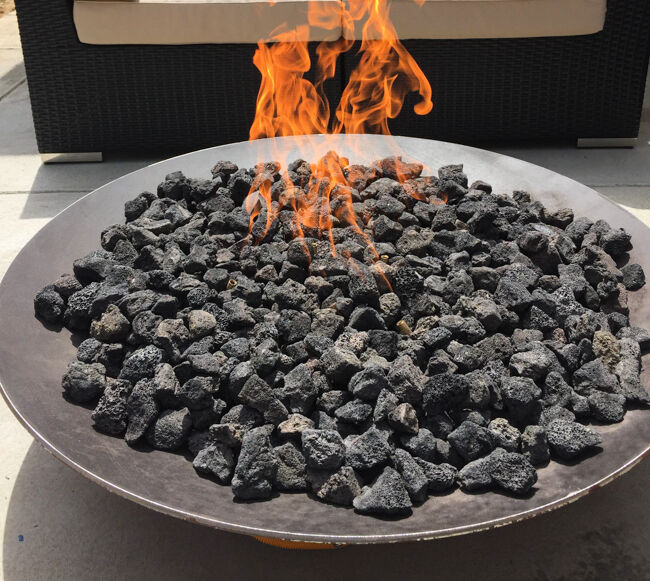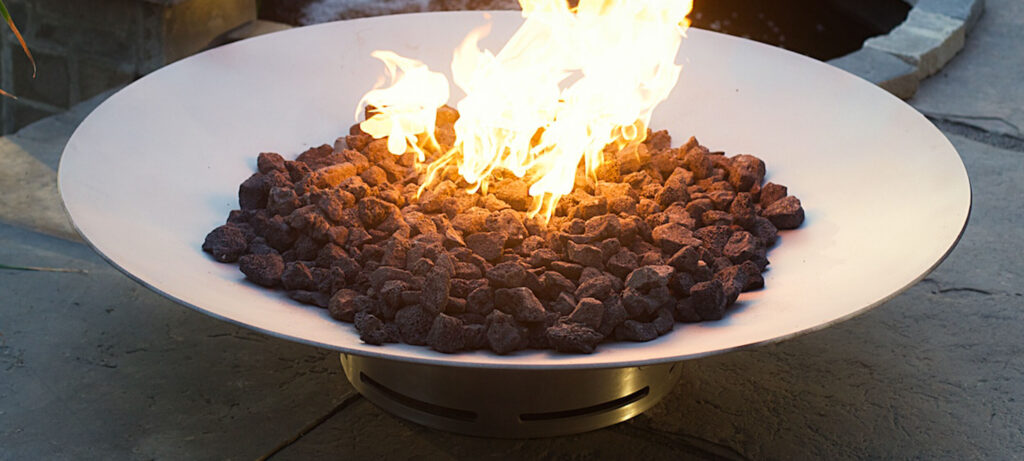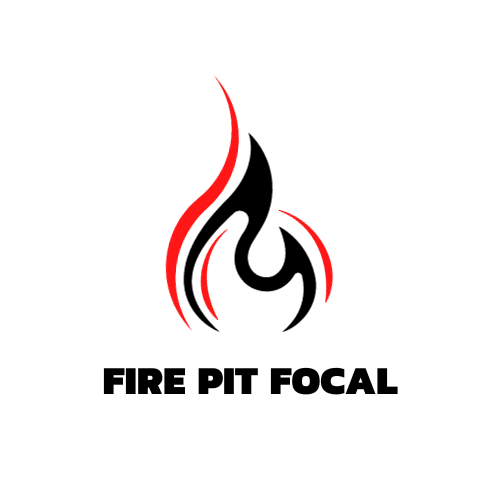If you’ve got a propane fire pit and you’re wondering whether you can swap out those ceramic logs for lava rocks, you’re in the right place! Lava rocks are a popular alternative to ceramic logs, and for good reason. Not only do they provide an eye-catching aesthetic with their natural, rustic appearance, but they also offer excellent heat distribution and retention. So, whether you’re looking to enhance the ambiance or wanting a more efficient heat source for your propane fire pit, let’s explore whether lava rocks are a suitable substitute for ceramic logs.

Benefits of Using Lava Rocks
Natural Appearance
One of the key benefits of using lava rocks in a propane fire pit is their natural appearance. Lava rocks have a unique texture and color that can add a rustic and earthy aesthetic to your outdoor space. Unlike ceramic logs, which can look artificial and manufactured, lava rocks provide a more authentic and organic look. They can blend seamlessly with any outdoor decor, whether you have a modern patio or a traditional backyard.
Heat Retention
Lava rocks are known for their excellent heat retention capabilities. When used in a propane fire pit, they can absorb and radiate heat effectively, creating a cozy and warm ambiance. This is particularly beneficial during colder months or chilly evenings when you want to maximize the heat output of your fire pit. The heat retained by the lava rocks can help keep you and your guests comfortable, allowing you to fully enjoy your outdoor gatherings.
Cost-effective
Using lava rocks in a propane fire pit is also a cost-effective option compared to ceramic logs. Lava rocks are typically more affordable and readily available in the market. They are a great alternative if you are on a budget or looking for a more economical solution for your outdoor fire feature. Additionally, lava rocks have a longer lifespan than ceramic logs, making them a cost-effective investment in the long run. Their durability ensures that you won’t have to replace them frequently, saving you both time and money.
How to Use Lava Rocks in a Propane Fire Pit
Preparing the Fire Pit
Before using lava rocks in your propane fire pit, it is essential to prepare the fire pit properly. Start by cleaning out any debris or ashes from previous fires. Make sure the burner is in good condition and working correctly. Check for any gas leaks and ensure that all connections are secure. This step is crucial for the safety and efficiency of your propane fire pit.
Placing the Lava Rocks
Once your fire pit is ready, you can start placing the lava rocks. Spread them evenly across the burner, making sure they cover the entire surface. It’s important not to overcrowd the rocks, as this can hinder the heat distribution. Leave some space between the rocks to allow for adequate airflow and combustion. As a general guideline, a layer of lava rocks that is around 2 to 4 inches thick should be sufficient for most propane fire pits.
Arranging the Rocks
After placing the lava rocks, you can arrange them to your desired aesthetic. Some people prefer a more uniform and organized arrangement, while others prefer a more natural and random placement. Consider the overall look you want to achieve and arrange the lava rocks accordingly. This step allows you to personalize your fire pit and create a visually pleasing display. Once you are satisfied with the arrangement, you are ready to enjoy the warmth and beauty of your propane fire pit with lava rocks.
Considerations when Using Lava Rocks in a Propane Fire Pit
Type of Fire Pit
When using lava rocks in a propane fire pit, it is crucial to consider the type of fire pit you have. Lava rocks are compatible with most propane fire pits designed for use with natural gas or propane. However, it’s always wise to consult the manufacturer’s instructions to ensure that lava rocks are suitable for your specific fire pit model. Some fire pits may have specific requirements or recommendations regarding the use of lava rocks or other alternative fire media.
Maintaining the Rocks
While lava rocks are relatively low maintenance, it’s essential to regularly inspect and clean them. Over time, debris, soot, and ashes may accumulate on the lava rocks, reducing their appearance and heat retention capabilities. To clean the lava rocks, remove them from the fire pit and rinse them with water. Gently scrub away any stubborn residue using a brush. Allow the rocks to dry completely before placing them back in the fire pit. Regular cleaning and maintenance will ensure that your lava rocks continue to look their best and provide optimal heat distribution.
Safety Precautions
Safety should always be a top priority when using a propane fire pit with lava rocks. Make sure to follow all safety guidelines provided by the manufacturer. Avoid placing flammable materials or objects near the fire pit, and always keep a fire extinguisher or water source nearby in case of emergencies. It’s also crucial to position your fire pit on a stable and non-flammable surface, away from any overhanging structures or trees. Regularly check the gas connections for leaks and ensure that the flame is always controlled and monitored. By taking these safety precautions, you can enjoy the warmth and beauty of your propane fire pit with peace of mind.
Alternatives to Lava Rocks in a Propane Fire Pit
Ceramic Logs
While lava rocks are a popular choice, ceramic logs are another widely used alternative for propane fire pits. Ceramic logs are designed to mimic the appearance of real wood logs, providing a traditional and classic look to your fire feature. They offer a realistic flame pattern and can enhance the overall ambiance of your outdoor space. Ceramic logs are also durable and long-lasting, making them a reliable choice for propane fire pit users.
Fire Glass
For those who prefer a more modern and contemporary look, fire glass is an excellent alternative to lava rocks. Fire glass is made from tempered glass and is available in various colors, sizes, and shapes. It creates a stunning visual effect, with the flames reflecting off the glass pieces, creating a mesmerizing display of light. Fire glass is also heat-resistant and does not produce any soot or ashes, making it a low-maintenance option for propane fire pits.
Pumice Stones
Pumice stones are another option to consider for your propane fire pit. They have a porous and lightweight texture, making them an excellent heat insulator. Pumice stones can retain heat efficiently and distribute it evenly throughout the fire pit, providing a consistent and cozy warmth. They also have a unique aesthetic appeal, with their rough and natural surface. Pumice stones are a more uncommon choice but can be a great alternative if you want to add a touch of uniqueness to your propane fire pit.

Where to Buy Lava Rocks
Home Improvement Stores
Lava rocks can be easily found in most home improvement stores. These stores typically have a wide range of landscaping and outdoor living products, including lava rocks. You can visit your local home improvement store and explore their selection of lava rocks. The advantage of buying lava rocks from these stores is that you can see and feel the rocks in person, ensuring that you choose the ones that meet your aesthetic preferences. The staff at these stores can also provide guidance and assistance if you have any questions or concerns.
Online Retailers
Another convenient option is to purchase lava rocks from online retailers. There are numerous online stores that specialize in landscaping and outdoor living products and offer lava rocks for sale. Buying online allows you to browse through a larger selection of lava rocks and compare prices from different sellers. Make sure to read customer reviews and ratings before making a purchase to ensure the quality and authenticity of the lava rocks. Additionally, check the shipping and return policies of the online retailer to ensure a smooth and satisfactory buying experience.
Local Landscaping Suppliers
Local landscaping suppliers are another potential source for lava rocks. These suppliers often carry a variety of materials and products for outdoor projects, including lava rocks. Visiting a local landscaping supplier gives you the opportunity to get expert advice and recommendations tailored to your specific needs. These suppliers may also have a wider selection of lava rocks compared to general home improvement stores. Additionally, supporting local businesses can contribute to the growth and development of your community.
Comparison between Lava Rocks and Ceramic Logs
Appearance
When comparing lava rocks and ceramic logs, the appearance is a significant factor to consider. Lava rocks provide a natural and rustic look, while ceramic logs offer a traditional and realistic wood log appearance. The choice ultimately depends on your personal preference and the aesthetic you want to achieve in your outdoor space. Some people prefer the rugged and earthy appeal of lava rocks, while others prefer the classic and timeless look of ceramic logs.
Heat Distribution
In terms of heat distribution, lava rocks and ceramic logs offer slightly different characteristics. Lava rocks are known for their exceptional heat retention properties, absorbing and radiating heat effectively. They can provide a consistent and prolonged heat output. On the other hand, ceramic logs, especially those specifically designed for heat distribution, can help create a more balanced and natural flame pattern. The logs act as a medium for the heat to disperse, resulting in a more even distribution of warmth.
Maintenance
In terms of maintenance, both lava rocks and ceramic logs are relatively low maintenance options for propane fire pits. Lava rocks may require occasional cleaning to remove debris and soot buildup, as mentioned earlier. Ceramic logs, on the other hand, may accumulate residue over time but can be easily cleaned with a damp cloth or brush. Regular inspections of both lava rocks and ceramic logs are essential to ensure their continued functionality and aesthetic appeal.

Customer Experiences with Lava Rocks in Propane Fire Pits
Positive Experiences
Many customers have reported positive experiences with using lava rocks in their propane fire pits. They appreciate the natural and authentic look that lava rocks provide, enhancing the overall ambiance of their outdoor space. Customers have also praised the heat retention capabilities of lava rocks, noting that they can create a cozy and warm environment for outdoor gatherings. Additionally, the cost-effectiveness of lava rocks has been praised, allowing customers to enjoy the benefits of a fire feature without breaking the bank.
Negative Experiences
Some customers have encountered negative experiences when using lava rocks in their propane fire pits. One common issue is the size and weight of the lava rocks. Some lava rocks may be larger or heavier than expected, making them challenging to handle and arrange in the fire pit. Another concern is the potential for the lava rocks to crack or break over time due to the extreme heat produced by the fire pit. While this is relatively rare, it’s important to choose high-quality lava rocks to minimize the risk of any damage.
Tips from Users
Based on customer experiences, here are some tips to ensure a successful use of lava rocks in a propane fire pit:
- Choose lava rocks of consistent size and weight to make arranging them easier.
- Consider layering the lava rocks with a heat-resistant mat or grate for added protection and stability.
- Regularly inspect and clean the lava rocks to maintain their appearance and heat distribution capabilities.
- Ensure proper ventilation and airflow around the lava rocks to facilitate combustion and efficient heat generation.
- Replace any cracked or damaged lava rocks to prevent any potential safety hazards.
By following these tips and taking proper care of your lava rocks, you can maximize their benefits and enjoy a beautiful and functional propane fire pit.
Conclusion
Ultimately, the choice between using lava rocks or ceramic logs in a propane fire pit comes down to personal preference and the desired aesthetic for your outdoor space. Lava rocks offer a natural appearance, excellent heat retention, and cost-effectiveness, making them a popular choice among propane fire pit users. However, ceramic logs provide a traditional and realistic look, with balanced heat distribution. Consider the specific considerations and alternatives discussed in this article in order to make an informed decision. With proper maintenance and safety precautions, you can create a warm and inviting atmosphere in your outdoor space and enjoy the benefits of your propane fire pit, whether you choose lava rocks or ceramic logs.


